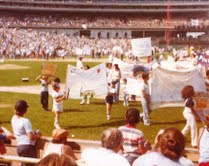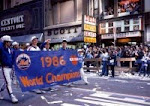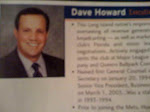Bob Scheffing was promoted to the Mets General Manager after the untimely death of Johnny Murphy in January 1970. The Mets had just come off their “Miracle” season of 1969 with their first Playoff, World Series and Championship in its brief seven year history.
The two sided answer to the question, was 1969 a fluke? That would be answered in the next coming months as the Mets prepared for yet another Spring Training in St. Petersburg Florida where they shared the training facilities with the St. Louis Cardinals.
Bob Scheffing came to the Mets organization after a career as a player with a little over 500 games with the Cubs, Reds, and Cardinals. A rather pedestrian .263 career lifetime average set no fires blazing in that realm. He managed both the Cubs and the Tigers, did a little broadcasting and some scouting before becoming the Mets GM.
I have nothing against the man personally and his only point of note in Mets history that it was under his tenure that Nolan Ryan was traded to the Angels for Jim Fregosi in what has been called the most lopsided trade in Mets history. Scheffing was put in a corner by Ryan. Nolan clearly not a big city boy absolutely hated New York and wanted out of this city in the worst way. So what did Scheffing do? He sent him to LA. Now that was a real small town in 1971. Right.
Here was a great opportunity for the Mets ownership to build this franchise and make it a force to be reckoned with for the next decade. They went with a relatively inexperience person in a front office position where they needed a power guy.
This, now looking back, begins the pattern of poor moves that we still see almost 40 years later.
Here is the starting lineup for the 1970 Mets.
1. Tommy Agee CF
2. Bud Harrelson SS
3. Joey Foy 3B
4. Cleon Jones LF
5. Art Shamsky 1B
6. Ron Swoboda RF
7. Wayne Garrett 2B
8. Jerry Grote C
9. Tom Seaver P
This was a pretty good team and it was expected to be near or at the top of the National League Eastern Division.
The Mets finished the 1970 season with an 83-79 record. They had the same record in 1971 and 1972 and although the pitchers did well, the lack of hitting and run production resulted in 3 straight 3rd place finishes.
I moved to Vernon Connecticut in August of 1970 because a good teaching job became available at a small private school specializing in Special Education. My wife’s, whose Mets record was now a glimmering 0-8 was pregnant with out first child and the house we rented had one of those huge roof top antennas’ which rotated 360 degrees. So I was now able to get both New York as well as Boston TV channels as clear as day. Life couldn’t get better than this.
Prior to the 1972 season, one of my boyhood heroes that I got to know personally, who by the way he carried himself with dignity and pride passed away. Gil Hodges was dead at 48 years old from a massive coronary heart attack, just like my Dad.
My memories of the years following the 69 Mets until the “Ya Gotta Believe” Tug McGraw’s rallying cry in the summer of 1973 were that of a fan who now expected his team should and could win all the games they played. Neither the team nor I, I’m sorry to say had a whole lot of enthusiasm. I had an excuse. They didn’t.
When they started their great comeback in the summer of ‘73’ the Mets sat in the cellar in the east with a 61-71 record. Yogi Berra who was as much fun as Casey Stengel was in the sixties, made one outrageous statement after another that kept the media close and put the spotlight on a team that seemed to cherish the limelight they were in. His best quote that year every fan in baseball knows, “It ain’t over till it’s over”. That was Yogi’s answer when asked about the Mets chances that summer.
On September 3rd 1970 Ellen and I drove to the city in my 1967 Dodge Charger with more horsepower beneath the hood than in all of General George Custer’s 7th Cavalry. I was so positive that “Her Streak” was going to end that day, I promised her dinner at Mama Leones in the city the next day.
The Mets had beaten the Phillies 5-0 the previous day and had won 3 of their last 4 so the NL Eastern Division had 5 teams within 6 games of 1st place all of them with a losing record. Oh the mediocrity, or oh the parity depending on your perspective.
The Mets led 3-2 going into the fifth inning and I was feeling good. Craig Swan was pitching well. He had given up a run in each of the first two innings but we had scored three. I figured if we win the game and end the streak I might even consider the request to have a third child which was very much on Ellen’s mind at the time. Barbara Lynn Marsh came to us on June 25th that year and I had her in Mets pink from day one, while my, now almost 3 year old son, Russell Michael was sporting his first Gil Hodges first baseman’s glove.
My dream however was short lived as Greg (The Bull) Luzinski blasted a 2 run homerun off Swan as the Phil’s went on to defeat the Mets 6-3.
Guess who never got to Mama Leones that next day. She was lucky I took her to Nathans for dogs and fries.
Over 30,000 of us went home thinking that no way were the Mets going to make it to the post season and her streak stood now at 9.
Of course, wouldn’t you know it, after my trip to Shea the Mets went on to win 18 of their next 25 and win the pennant with an 82-79 record. Now this was a miracle.
Every lifelong Mets fan alive knows that these underdogs of underdogs went on to beat up the Big Red Machine in the playoffs and Bud Harrelson kicked Pete Rose’s ass.
They also just missed winning their second World Series in 5 years as they led the powerful Oakland A’s 3games to 2 with Seaver and Koosman to pitch game 6 and 7. But that victory was not meant to be.
That year ended another streak in Mets history. They finished over .500 for 5 consecutive years. They had the opportunity to become a dynasty with this team. The ownership made poor decisions from the GM down. Mrs. Payson might have been a wonderful little old lady but she knew squat about baseball and turned the operation over to people who knew little more than she did. The fact that they did as well as they did during these 5 years was because they had kept some of the great talented pitching core together with the exception of Nolan Ryan. Plus frankly during this time the rest of the National League wasn’t having any breakout teams as of yet.
This trend will only get worse during the next 10 years which I call “The Lost Years” coming to you in part 5 of the Anatomy of a Franchise.
Thanks for listening.














Post a Comment